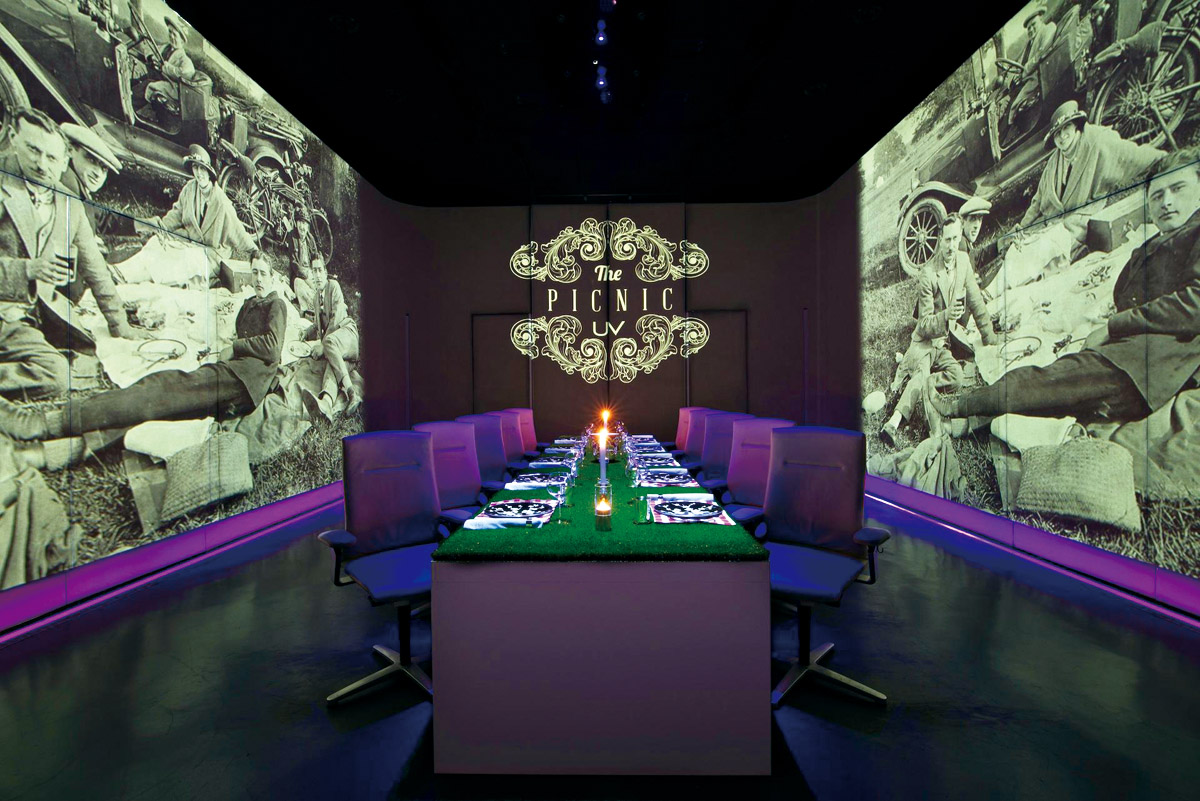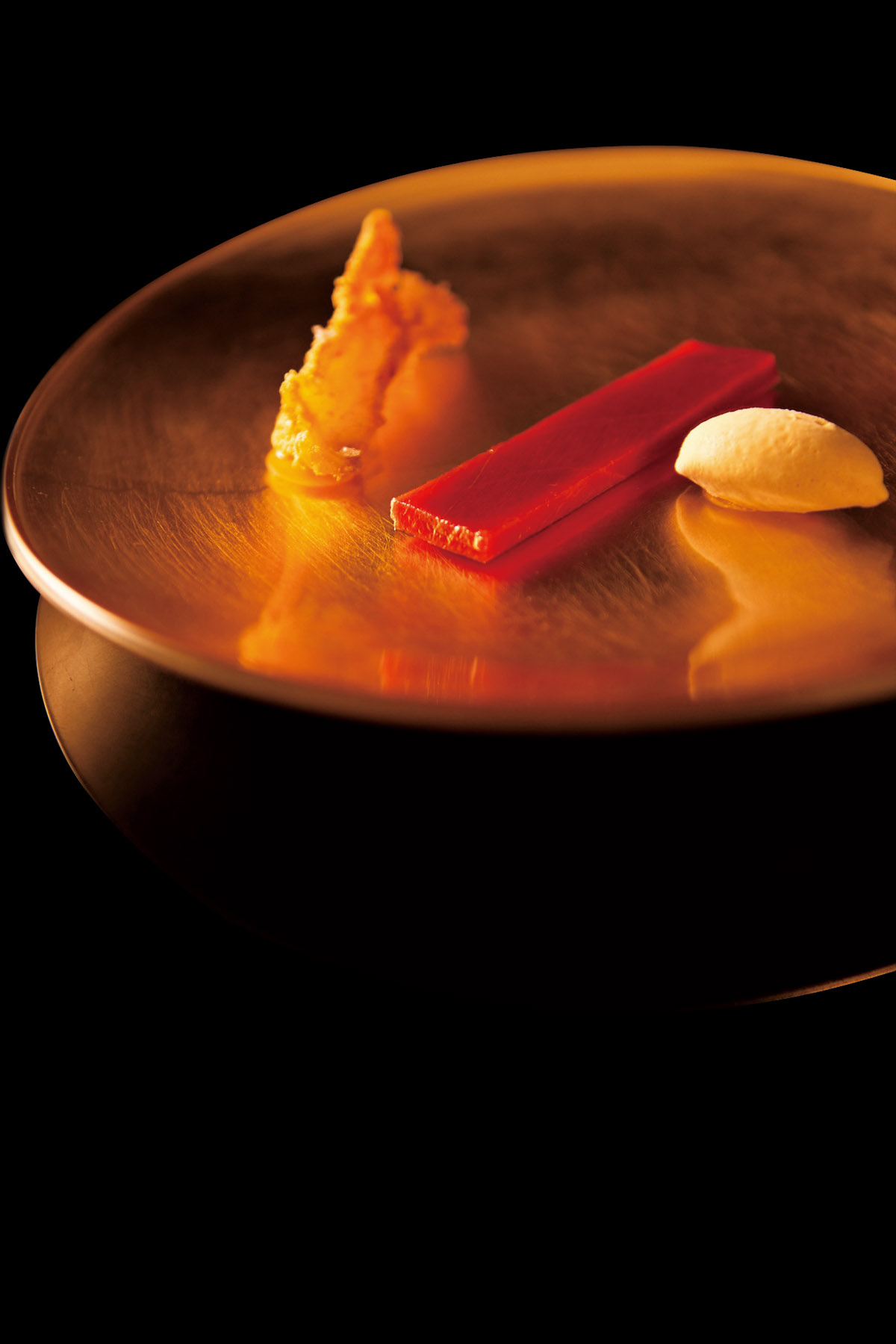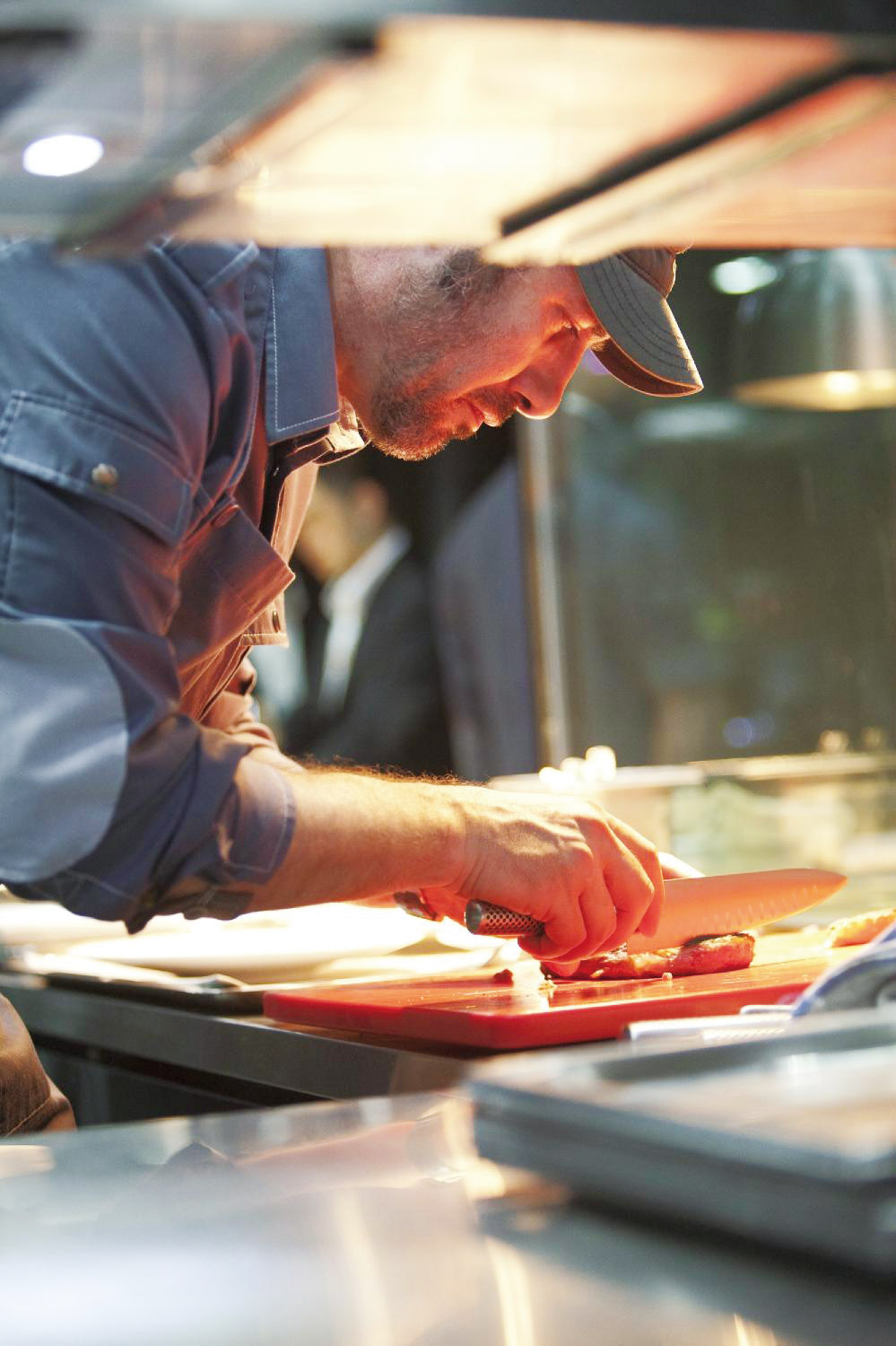上海UV紫外线餐厅 颠覆就餐体验
撰文/张泽坤 Written by Alan
有一家餐厅:一天只接待十个客人,二十道固定的菜式,四小时的用餐时间,还要提前三个月预订才排得上号;只能通过餐厅官网预订,没有其他渠道,没有具体地址,不能私自前往,统一集合后发车把客人送到用餐地点;在上海,这间餐厅荣登成为上海奢侈饮食界新贵。

这家刚被评为米其林三星的前卫餐厅,是由沪上法国名厨Paul Pairet于2012年夏季在贸御企业管理咨询(上海)有限公司的支持下创办,整个投资超过250万美金,号称“全世界第一个感官餐厅”,上海的紫外线餐厅。这间餐厅的特别之处是通过多种技术支撑,每道菜肴都有为增加其味觉而量身定制的用餐氛围,包括视觉、听觉和嗅觉的组合物。想要顺利就餐,只能在其官网预定,经过数月等待后,用餐当晚在上海外滩18号Mr & Mrs Bund餐厅的楼下,一辆专用的商务车将接送客人前往UV。车子顺着苏州河沿岸转入几条七拐八拐的小巷,停靠到一个破旧的由老工厂改造的“创意园区”里面。下车后,客人将被带到一栋看似仓库的厂房前面,很神秘,这么破旧的大门里究竟藏着什么乾坤呢?
跨过这个入口,一段奇异的感官之旅便已启程。UV的主餐厅是一个类似“骇客帝国”电影里的科幻实验室,四面高墙,充满“纯白色,未来感”的情调。位于这个高耸白色空间的正中央,是类似会议室的摆设——一个巨大的白色长桌和10张白色工作椅。头顶上,有7部投影机和一系列镁光灯,空气中散发着某些未知香料的味道,这一切,都活似一个拍摄未来风格电影的制片厂。晚宴主人Fabien Verdier会指引每一位客人走到有他自己名字的座位前,座位铭牌则是用灯光特意投射而现,具有浓烈的专属尊贵感。所有客人坐下后,主人只身离开,灯光渐暗,好戏即将上演。然后,让所有人大开眼界的一刻出现了——四面墙上的大屏幕突然亮起,因为错觉,顾客会感到整个房间在迅速下沉房间下沉得越来越快,四面墙上的影像迅速转变,每位客人的视觉将被强烈吸引着。

在四小时的用餐时段里,二十道佳肴与十二道酒水的套餐被划分为不同的主题,每一道菜都会搭配独特的餐具、影像、音乐、气味,屏幕墙上会显示相关菜品名称信息,菜品的造型和创意烹饪也让人惊喜连连。目前,Ultraviolet的特色菜包括鹅肝酱、面包海鲈鱼、海水浸龙虾、黑松露羊排、超级玛丽啫喱冻等创意菜式。客人舒服,才是最好的服务体现。除了菜品和氛围的凝造外,餐厅的服务理念也是别树一帜,服务生统一穿着蓝领工作服,休闲西装以及牛仔裤,没有标准化的职业微笑,没有过分谦恭的态度,在餐厅里,不论身份高低,每一位客人都将被视为家人般亲切友好的对待。

餐厅创始人Paul Pairet表示,从1996年的时候就开始萌生创造一间科技餐厅的想法。“我并不是仅仅为中国食客们创造,而是想要创造一种新的体验,这种新的体验不一定就能满足需求。例如紫外线这家餐厅,我不会做任何的市场营销去满足大家的需求,固定设计的一套菜单,令我能充分掌握时间从而配合餐厅氛围的营造,从而创造一个不可能存在的生活方式。每一座城市都有他的地标,没有 Ultraviolet 的上海饮食界,将不再完整。Ultraviloet 提供的不仅仅是食物,是如梦似幻的浸润式用餐体验,创造的是充满希望的情感和记忆。
CREATING A GAME-CHANGING EXPERIENCE OF FINE DINNERULTRAVIOLET RESTAURANTS IN SHANGHAI
A single table of ten seats only. A 20-course “Avant-Garde” set menu. All the guests sit together. The experience begins. Food leads. Dinner unfolds as a sensory play choreographed by Chef Pairet and the Ultraviolet team. The new three-star Michelin restaurant, Ultraviolet is the first experimental restaurant of its kind.
Billed as the first multi-sensory restaurant in the world, Ultraviolet uses sight, sound and smell to enhance the food through a controlled and tailored atmosphere. The restaurant has a single table of 10 seats and serves a single 20+ course dinner menu for ten guests each night.
The dining room of Ultraviolet is ascetic with no décor, no artifacts, no paintings, and no views. It is a purpose-built room specifically equipped with multi-sensory high-end technology such as dry scent projectors, stage and UV lighting, 360-degree wall projection, table projectors, beam speakers and a multichannel speaker system. Each course of the menu is dressed-up by lights, sounds, music, and /or scents, and enhanced with its own tailored atmosphere to provide context for the dish’s taste.
Ultraviolet originally evolved from Pairet’s desire to reduce the technical constraints of the traditional restaurant, which is organized to provide “a la carte” service. This type of organization requires preparation methods that Pairet considers “sub-standard”.
By monitoring the timing of the courses and offering a fixed menu, Ultraviolet is able to optimize the control and the quality of cooking in ways that the majority of traditional restaurants cannot – a model that has roots in the historical “table d’hôte” concept.
This control allows Ultraviolet to play on and intentionally direct the atmosphere for each dish through multi-sensory technology.
Ultraviolet incorporates technology traditionally used in unrelated fields to drive and control the “psycho taste” and enhance the perception of food.
This concept is based on Pairet’s interest and desire to stimulate what he calls the ‘psycho-taste’. Howie Kahn, writing in the New York Times, conveyed Pairet’s idea that ‘psycho taste’ allows eating to “act as a gateway to the mind” and “it delves into the notion that memories, associations, expectations, ideas, misunderstandings, joys and fears all play a role in the experience of a meal.” Pairet, among others, believes that our perception of taste can be altered by a lot of factors such as expectations, memory, mood, weather, surrounding, trivial, … everything about the taste. By staging the ambiance assigned to a dish as we eat, he attempts to trigger emotion and uplift the perception and memory of a dish. Pairet has been quoted as saying “Food is ultimately about emotion, and emotion goes beyond taste.”
Billed as the first multi-sensory restaurant in the world, Ultraviolet uses sight, sound and smell to enhance the food through a controlled and tailored atmosphere. The restaurant has a single table of 10 seats and serves a single 20+ course dinner menu for ten guests each night.
The dining room of Ultraviolet is ascetic with no décor, no artifacts, no paintings, and no views. It is a purpose-built room specifically equipped with multi-sensory high-end technology such as dry scent projectors, stage and UV lighting, 360-degree wall projection, table projectors, beam speakers and a multichannel speaker system. Each course of the menu is dressed-up by lights, sounds, music, and /or scents, and enhanced with its own tailored atmosphere to provide context for the dish’s taste.
Ultraviolet originally evolved from Pairet’s desire to reduce the technical constraints of the traditional restaurant, which is organized to provide “a la carte” service. This type of organization requires preparation methods that Pairet considers “sub-standard”.
By monitoring the timing of the courses and offering a fixed menu, Ultraviolet is able to optimize the control and the quality of cooking in ways that the majority of traditional restaurants cannot – a model that has roots in the historical “table d’hôte” concept.
This control allows Ultraviolet to play on and intentionally direct the atmosphere for each dish through multi-sensory technology.
Ultraviolet incorporates technology traditionally used in unrelated fields to drive and control the “psycho taste” and enhance the perception of food.
This concept is based on Pairet’s interest and desire to stimulate what he calls the ‘psycho-taste’. Howie Kahn, writing in the New York Times, conveyed Pairet’s idea that ‘psycho taste’ allows eating to “act as a gateway to the mind” and “it delves into the notion that memories, associations, expectations, ideas, misunderstandings, joys and fears all play a role in the experience of a meal.” Pairet, among others, believes that our perception of taste can be altered by a lot of factors such as expectations, memory, mood, weather, surrounding, trivial, … everything about the taste. By staging the ambiance assigned to a dish as we eat, he attempts to trigger emotion and uplift the perception and memory of a dish. Pairet has been quoted as saying “Food is ultimately about emotion, and emotion goes beyond taste.”
本网站部分图片来源于网络,如有侵权,请联系780236430@qq.com ,我们会在5个工作日内查证删除。图片其版权均归原作者及其网站所有。


